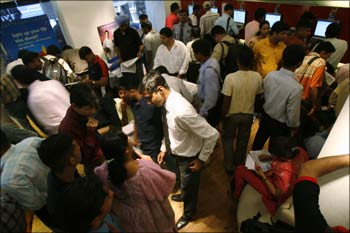Photographs: Arko Datta/Reuters BankBazaar.com
Here is a simplified idea of how to analyse initial public offerings (IPOs) using technical and fundamental analysis.
There have been raging discussions during the past three years, both, when the Indian IPO market was booming and when it was crashing.
Should we invest in IPOs or rather buy the stock when it comes to the secondary market? The debate over this a long-drawn one with varying answers during boom and bust.
This article will try to give some tools and ratios, which help us decide whether to invest in an IPO or not at any time!
Analysis based on market value (market cap)
Market value in the case of an IPO can be defined as the number of shares available for subscription multiplied by the price per share plus the price per share multiplied by outstanding shares if any.
In the case of analysis, when there is a price band available, it's advisable to do the analysis based on the lowest price.
Investing in an IPO? Read this!
Image: People walk pass the Bombay Stock Exchange building.Photographs: Punit Paranjpe/Reuters
Check 1: Price to Sales (P/S) ratio
This number is derived by dividing the market value by the value of annualised sales. It can also be derived by dividing the price of a share by the sales per share. It is basically an indication of the amount the company is trying to garner from the market vis-a-vis its current business.
A rule of thumb for the P/S ratio when deciding on IPO investment is that lower the P/S ratio the better it is as an investment.
A word of caution is that it should not be the only parameter before deciding.
Check 2: Price to Earnings (or Loss) P/E ratio
This number is derived by dividing the market value by the annualised profits (loss) for the company. It is an indicator of the number of multiples that the market is ready to pay for the stock over its current profit levels.
If the profit is Rs 2,500 crore (Rs 25 billion) and number of equity shares is 1,000, then the P/E is 2.5. Meaning, the market is ready to pay 2.5 times the profit per share to buy the stock.
Thumb Rule for P/E with respect to IPOs
The lower the P/E, the better it is for the investor. In simple terms, a lower P/E means, you are getting to buy something that has the ability to reap high benefits at a very cheap price.
The irony is that during boom times uninformed investors get carried away by high P/E multiples.
Investing in an IPO? Read this!
Image: A broker reacts while trading at a stock brokerage firm in Mumbai.Photographs: Arko Datta/Reuters
Check 3: Price to Book value (P/B) ratio
The book value is defined as the difference between total assets and liabilities. In a more crude way, it is also defined as the amount that will be left back after paying all liabilities in case of a closure.
The P/B of an IPO is calculated as market value divided by the book value. It gives an idea on what value the market places on the stock based on its books.
Thumb rule: Lower the P/B the better. It would be advisable for a potential IPO investor to look for IPOs with low P/B. Some of these stocks are called value stocks.
Long-term investors buy such companies and hold on to them till they slowly but steadily grow their business till a day when the share prices might shoot up phenomenally and then exit with huge profits.
Check 4: Price to Tangible Book Value (PTBV) ratio
This number is derived by dividing the market value by the tangible book value. The Tangible Book Value (TBV) is equal to the book value of the company minus the intangible assets.
Intangible assets are those that cannot be seen or felt. Examples include IP rights, goodwill patents, etc. Similar to P/B, it can also be crudely seen as the amount an investor would get if the company ceases to exist and all its assets have to be sold.
The reason it is seen separately is that most intangible assets would be very difficult to sell in case of closure.
Thumb rule: Lower the PBTV the better. A PBTV of 0-1.0 (zero to one) means the company is trading at or below the worth of its own tangible assets. Once the mark crosses one, the risk for the investor too is proportionally higher.
In case of certain companies the PBTV could be negative too.
Investing in an IPO? Read this!
Image: Sweden's Crown Princess Victoria poses with a bronze replica of a bull during her visit to the Bombay Stock Exchange building in Mumbai.Photographs: Punit Paranjpe/Reuters
Check 5: Gross margin percentage
The gross margin percentage is derived by dividing the gross margin of the company (the margin before accounting for taxes, depreciation, expenses, etc) by the total value of sales. This gives an idea of what is the percentage of margins for any value of sales.
Thumb rule: Higher the gross margin the better. This in simple terms indicates that the company's product of service has a good margin of income. The higher the gross margin, the better would be the actual profit. For certain industries where costs are very high the gross margin percentage would be low.
In such cases, we need to analyse if it's higher than for other competitors in the same domain of business.
Check 6: Profit margin percentage
This number is derived by dividing the profits by total value of sales. Again, as in the case of gross margin percentage, higher the profit margin percentage, the better it would be to invest in the IPO of that company.
A word of caution, though. The gross profit margin percentage and the profit margin percentage should be analysed for at least 3-4 years to check for consistency.
Some companies might show higher margins due to one off reasons which might not hold true after the IPO.
All the above calculations need to be taken into consideration along with the analysis of the company's management, its business model, the sustainability of its product/service and other such fundamental parameters while deciding to invest in an IPO or not.





article